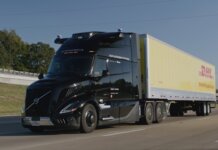The Low Carbon Vehicle Partnership (LowCVP) and the Energy Saving Trust (EST), together with industry stakeholders, have launched the Clean Vehicle Retrofit Accreditation Scheme (CVRAS) in the U.K.
Although the latest ultra-clean Euro VI buses and advanced electrified options meet clean emission requirements, a significant majority of the older, existing bus fleet are seen as being a significant source of pollution and require a rapid and cost-effective solution.
By providing a single standard for any emission technology to be validated to meet the standards set out in the government’s Clean Air Zone Framework for England, the scheme will enable the existing fleet of urban vehicles (initially buses, but extending rapidly to a wide range of vehicles) to be fitted with proven emission control solutions.
According to the LowCVP, this scheme will provide the backbone of future retrofit funding.
Larger vehicles (buses, vans and heavy goods vehicles) contribute over half of U.K. national average roadside concentration of nitrogen dioxide, according to Defra’s AQ analysis. Next year, the government will publish a comprehensive Clean Air Strategy that will address other sources of air pollution.
As reported, the Clean Vehicle Retrofit Accreditation Scheme will provide independent evidence that a vehicle retrofit technology will deliver the expected emissions reductions and air quality benefits in real-world operation. It will enable drivers, technology manufacturers, businesses and local authorities to be confident that properly verified and accredited technologies provide the appropriate emissions reductions to meet the standards in the government’s Clean Air Zone Framework for England.
The initial objectives of the scheme, are to develop a set of test protocols (using the existing bus and commercial vehicle technology evaluation schemes as starting points) to accredit retrofit technologies that will deliver on-road emission levels equivalent to Euro VI/6, based on the best available data and representative operating cycles.
According to the LowCVP, the retrofit accreditation process will be technology-neutral and designed to allow all potential suppliers of eligible, credible emission-reduction technology to apply for accreditation.
LowCVP says some technologies already potentially identified and in common use include selective catalytic reduction fitted to exhaust systems, hybrid powertrain systems, and engine repowers with gasoline (LPG or CNG). New technologies will need to provide robust, independent relevant test data of the performance, prior to being considered for CVRAS accreditation.
Andy Eastlake, LowCVP’s managing director, says, “The most effective retrofit technologies can cut polluting emissions by over 95%. But, it is critical that these systems are properly calibrated and matched to the vehicle and its operation and that we have a common and robust approval system.
“By making sure that we fit a range of the most appropriate technologies to the right vehicles, retrofitting can make a very significant, immediate impact on our air quality problems, supporting the complementary strategy to adopt new vehicles as quickly as economically viable,” he says. “As you would expect from the LowCVP, our accreditation process will also ensure that there is no adverse impact on fuel efficiency or carbon emissions and aims to maximize the simultaneous benefits for both the environment and climate.”
EST’s Transport Certification Manager Colin Smith adds, “Appropriately retrofitting the legacy fleet will bring immediate benefits. However, having confidence in which systems to fit and which solutions work is key for both vehicle operators and the local authorities implementing CAZs.”
“This is where a robust certification scheme will play a vital role and give assurance to stakeholders in verifying the emission reduction technologies and those that supply them in a consistent, comparable and trusted manner,” he continues. “As the scheme has been set up as technology neutral, any new technology can also be tested in a consistent a comparable way ensuring that real emissions reductions are achieved and air quality is improved for all.”






